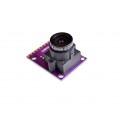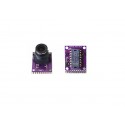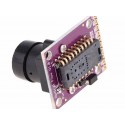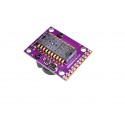Optical Flow Sensor V1.0
Rs. 1,063.00 Rs. 1,212.00
- Brand: https://www.broadcom.com/news/press-release/agilent_technologies
- Product Code: SEN-TOF
- Availability: In Stock
- Price in reward points: 14
- For Bulk Order
 9962060070
9962060070
A drift transfer is a kind of stage sensor, a tool used to stumble on the level of liquid within a tank. It is neither a complicated circuit nor does it provide electricity. It is a simple structure, smooth to use stage manipulate device; furthermore, this transfer has a mechanical switch than the ones of the average small sized switches.
As lengthy because the fabric used is in the ideal form and nature of any liquid or strain, you could manipulate the temperature. Applications of this Switch encompass shipbuilding industry, generating equipment, petrochemical and food enterprise, water remedy system, dyeing, and completing industry, and hydraulic machinery.
Features:
1. Reed switch contact material is rhodium (rhodium oxide surface coverage)
2. Special handling reed switches can make it in 140 ˚C high temperature under normal use
3. Overall performance and reliable float switch
4. Long-lasting life: Up to 100 million times
5. Switch Length: 55 mm
6. Cable Length: 300 mm
| SPECIFICATIONS | |
| Memory Capacity | 1 GB Processor |
| Material | Plastic |
OVERVIEW:
-This Optical flow sensor for APM2.5 APM 2.6 APM 2.8 flight controller is used for multicopter.
-The sensor only works in well-lit environments.
-Memory Capacity: 1 GB Processor.
-Material: Plastic.
PACKAGE INCLUDES:
1 PCS x Optical Flow Sensor V1.0
https://www.broadcom.com/news/press-release/agilent_technologies_ships_50_millionth_optical_mouse_sensor
//SOURCE CODE TAKEN FRON BELOW LINK
//https://github.com/Neumi/OpticalFlowA3080ArduinoProcessing/blob/master/ArduinoA3080/ArduinoA3080.ino
#include "SPI.h"
// Original Code by: Simon Winder
// https://github.com/impressivemachines/Arduino
// https://www.youtube.com/user/robotbugs
// small changes by: Jan Neumann aka. Neumi
// https://github.com/Neumi
// https://www.youtube.com/user/NeumiElektronik
// All code is published unter MIT license. Feel free to use!
// these pins may be different on different boards
// this is for the uno
#include <SoftwareSerial.h>
SoftwareSerial mySerial(6, 7); // RX, TX
#define PIN_SS 10
#define PIN_MISO 12
#define PIN_MOSI 11
#define PIN_SCK 13
#define PIN_MOUSECAM_RESET 3
#define PIN_MOUSECAM_CS 2
#define ADNS3080_PIXELS_X 30
#define ADNS3080_PIXELS_Y 30
#define ADNS3080_PRODUCT_ID 0x00
#define ADNS3080_REVISION_ID 0x01
#define ADNS3080_MOTION 0x02
#define ADNS3080_DELTA_X 0x03
#define ADNS3080_DELTA_Y 0x04
#define ADNS3080_SQUAL 0x05
#define ADNS3080_PIXEL_SUM 0x06
#define ADNS3080_MAXIMUM_PIXEL 0x07
#define ADNS3080_CONFIGURATION_BITS 0x0a
#define ADNS3080_EXTENDED_CONFIG 0x0b
#define ADNS3080_DATA_OUT_LOWER 0x0c
#define ADNS3080_DATA_OUT_UPPER 0x0d
#define ADNS3080_SHUTTER_LOWER 0x0e
#define ADNS3080_SHUTTER_UPPER 0x0f
#define ADNS3080_FRAME_PERIOD_LOWER 0x10
#define ADNS3080_FRAME_PERIOD_UPPER 0x11
#define ADNS3080_MOTION_CLEAR 0x12
#define ADNS3080_FRAME_CAPTURE 0x13
#define ADNS3080_SROM_ENABLE 0x14
#define ADNS3080_FRAME_PERIOD_MAX_BOUND_LOWER 0x19
#define ADNS3080_FRAME_PERIOD_MAX_BOUND_UPPER 0x1a
#define ADNS3080_FRAME_PERIOD_MIN_BOUND_LOWER 0x1b
#define ADNS3080_FRAME_PERIOD_MIN_BOUND_UPPER 0x1c
#define ADNS3080_SHUTTER_MAX_BOUND_LOWER 0x1e
#define ADNS3080_SHUTTER_MAX_BOUND_UPPER 0x1e
#define ADNS3080_SROM_ID 0x1f
#define ADNS3080_OBSERVATION 0x3d
#define ADNS3080_INVERSE_PRODUCT_ID 0x3f
#define ADNS3080_PIXEL_BURST 0x40
#define ADNS3080_MOTION_BURST 0x50
#define ADNS3080_SROM_LOAD 0x60
#define ADNS3080_PRODUCT_ID_VAL 0x17
void mousecam_reset()
{
digitalWrite(PIN_MOUSECAM_RESET,HIGH);
delay(1); // reset pulse >10us
digitalWrite(PIN_MOUSECAM_RESET,LOW);
delay(35); // 35ms from reset to functional
}
int mousecam_init()
{
pinMode(PIN_MOUSECAM_RESET,OUTPUT);
pinMode(PIN_MOUSECAM_CS,OUTPUT);
digitalWrite(PIN_MOUSECAM_CS,HIGH);
mousecam_reset();
int pid = mousecam_read_reg(ADNS3080_PRODUCT_ID);
if(pid != ADNS3080_PRODUCT_ID_VAL)
return -1;
// turn on sensitive mode
mousecam_write_reg(ADNS3080_CONFIGURATION_BITS, 0x19);
return 0;
}
void mousecam_write_reg(int reg, int val)
{
digitalWrite(PIN_MOUSECAM_CS, LOW);
SPI.transfer(reg | 0x80);
SPI.transfer(val);
digitalWrite(PIN_MOUSECAM_CS,HIGH);
delayMicroseconds(50);
}
int mousecam_read_reg(int reg)
{
digitalWrite(PIN_MOUSECAM_CS, LOW);
SPI.transfer(reg);
delayMicroseconds(75);
int ret = SPI.transfer(0xff);
digitalWrite(PIN_MOUSECAM_CS,HIGH);
delayMicroseconds(1);
return ret;
}
struct MD
{
byte motion;
char dx, dy;
byte squal;
word shutter;
byte max_pix;
};
void mousecam_read_motion(struct MD *p)
{
digitalWrite(PIN_MOUSECAM_CS, LOW);
SPI.transfer(ADNS3080_MOTION_BURST);
delayMicroseconds(75);
p->motion = SPI.transfer(0xff);
p->dx = SPI.transfer(0xff);
p->dy = SPI.transfer(0xff);
p->squal = SPI.transfer(0xff);
p->shutter = SPI.transfer(0xff)<<8;
p->shutter |= SPI.transfer(0xff);
p->max_pix = SPI.transfer(0xff);
digitalWrite(PIN_MOUSECAM_CS,HIGH);
delayMicroseconds(5);
}
// pdata must point to an array of size ADNS3080_PIXELS_X x ADNS3080_PIXELS_Y
// you must call mousecam_reset() after this if you want to go back to normal operation
int mousecam_frame_capture(byte *pdata)
{
mousecam_write_reg(ADNS3080_FRAME_CAPTURE,0x83);
digitalWrite(PIN_MOUSECAM_CS, LOW);
SPI.transfer(ADNS3080_PIXEL_BURST);
delayMicroseconds(50);
int pix;
byte started = 0;
int count;
int timeout = 0;
int ret = 0;
for(count = 0; count < ADNS3080_PIXELS_X * ADNS3080_PIXELS_Y; )
{
pix = SPI.transfer(0xff);
delayMicroseconds(10);
if(started==0)
{
if(pix&0x40)
started = 1;
else
{
timeout++;
if(timeout==100)
{
ret = -1;
break;
}
}
}
if(started==1)
{
pdata[count++] = (pix & 0x3f)<<2; // scale to normal grayscale byte range
}
}
digitalWrite(PIN_MOUSECAM_CS,HIGH);
delayMicroseconds(14);
return ret;
}
void setup()
{
pinMode(PIN_SS,OUTPUT);
pinMode(PIN_MISO,INPUT);
pinMode(PIN_MOSI,OUTPUT);
pinMode(PIN_SCK,OUTPUT);
SPI.begin();
SPI.setClockDivider(SPI_CLOCK_DIV32);
SPI.setDataMode(SPI_MODE3);
SPI.setBitOrder(MSBFIRST);
Serial.begin(9600);
if(mousecam_init()==-1)
{
Serial.println("Mouse cam failed to init");
while(1);
}
}
char asciiart(int k)
{
static char foo[] = "WX86*3I>!;~:,`. ";
return foo[k>>4];
Serial.begin(9600);
}
byte frame[ADNS3080_PIXELS_X * ADNS3080_PIXELS_Y];
void loop()
{
#if 0
// if enabled this section grabs frames and outputs them as ascii art
if(mousecam_frame_capture(frame)==0)
{
int i,j,k;
for(i=0, k=0; i<ADNS3080_PIXELS_Y; i++)
{
for(j=0; j<ADNS3080_PIXELS_X; j++, k++)
{
Serial.print(asciiart(frame[k]));
Serial.print(' ');
}
Serial.println();
}
}
Serial.println();
delay(250);
#else
// if enabled this section produces a bar graph of the surface quality that can be used to focus the camera
// also drawn is the average pixel value 0-63 and the shutter speed and the motion dx,dy.
int val = mousecam_read_reg(ADNS3080_PIXEL_SUM);
MD md;
mousecam_read_motion(&md);
/*
for(int i=0; i<md.squal/4; i++)
Serial.print('*');
Serial.print(' ');
Serial.print((val*100)/351);
Serial.print(' ');
*/
//Serial.print(md.shutter); Serial.print(" (");
int X = (int)md.dx;
int Y = (int)md.dy;
if(X > -1) Serial.print("+");
if(X < 0) Serial.print("-");
if(abs(X) < 10) Serial.print("0");
Serial.print(abs(X));
Serial.print(',');
if(Y > -1) Serial.print("+");
if(Y < 0) Serial.print("-");
if(abs(Y) < 10) Serial.print("0");
Serial.println(abs(Y));
/*
Serial.print((int)md.dx); Serial.print(',');
Serial.println((int)md.dy); //Serial.println(')');
// Serial.println(md.max_pix);
*/
delay(10);
#endif
}





